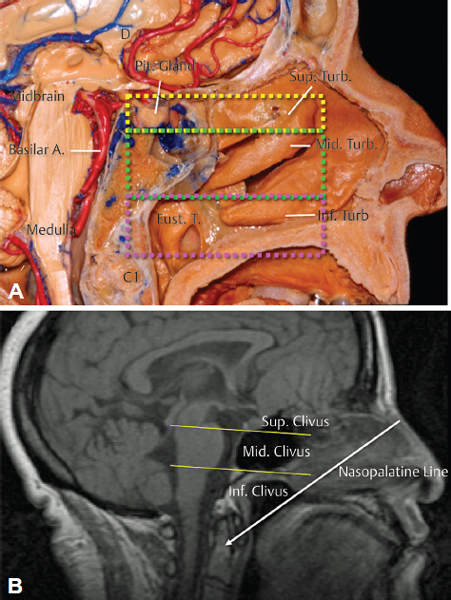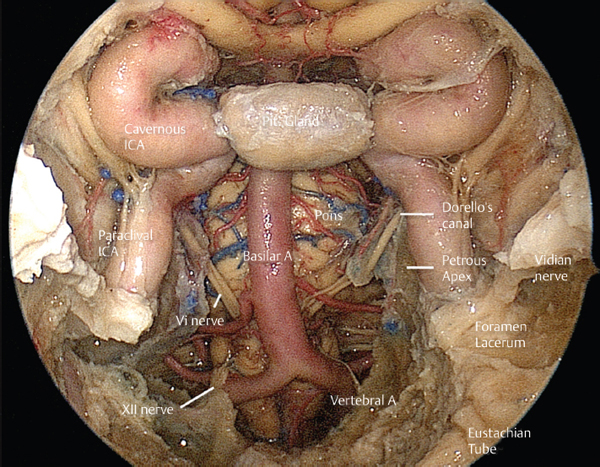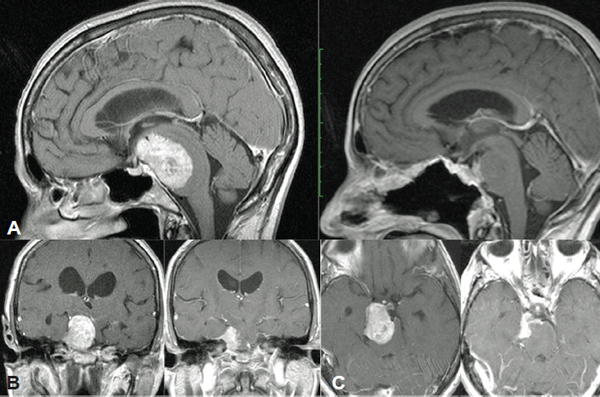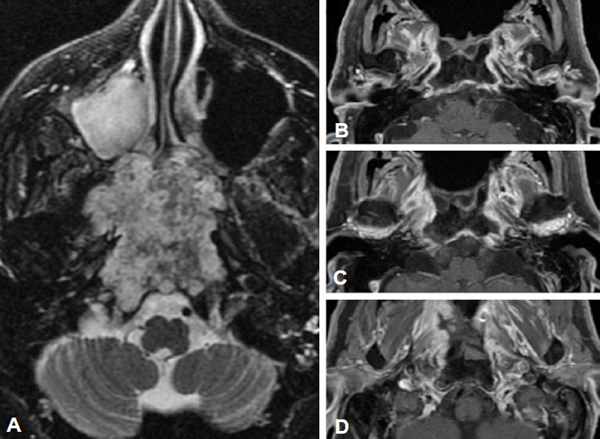29 Endoscopic Surgery for Clival and Posterior Fossa Lesions Endonasal approaches to the skull base are classified based on their orientation in sagittal and coronal planes.1 In the sagittal plane, the endonasal approach provides access to lesions of the clivus and posterior fossa from the posterior clinoids to the foramen magnum and upper cervical spine. In the posterior (inferior) coronal plane, the endonasal approach extends laterally below the petrous bone to the medial jugular tubercle and jugular bulb. For centrally located lesions, an endonasal approach provides maximal access with minimal manipulation of normal neural and vascular structures. Limitations of the approach are established by the pituitary gland, the course of the internal carotid artery (ICA) and the cranial nerves, and involvement of intradural structures. The clivus is divided into three sections: superior, middle, and inferior (Fig. 29.1). The superior clivus is situated posterior to the pituitary gland and extends from the posterior clinoids to the floor of the sella. It is bounded laterally by the cavernous sinus and cavernous segment of the ICA. Intracranially, the superior clivus is associated with the third cranial nerve and the basilar apex. The middle clivus corresponds to the clival recess and extends from the bottom of the sella to the floor of the sphenoid sinus. It is bounded laterally by the paraclival segment of the ICA and the medial petrous apex. Intracranially, the middle clivus is associated with the distal part of the sixth cranial nerve as it passes deep to the paraclival ICA and enters Dorello canal on the superior surface of the petrous bone (Fig. 29.2). The inferior clivus extends from the floor of the sphenoid sinus to the foramen magnum. Laterally, it is bounded by the petroclival junction, medial jugular tubercle, and the occipital condyles. Intracranially, the lower third of the clivus is associated with the vertebral arteries, vertebrobasilar junction, and the associated origin of the sixth cranial nerve and the ninth, tenth, and twelfth cranial nerves. Caudally, the first and second cervical vertebrae (C1 and C2) are situated posterior to the nasopharynx. Access is bounded by the eustachian tubes laterally and the plane of the palate inferiorly (Fig. 29.1). The ring of C1 lies just below the level of the hard palate and is superficial to the odontoid process (superior part/peg of C2). The occipital condyles articulate with the lateral mass of C1. The vertebral artery is situated posterolaterally and pierces the dura between the posterior foramen magnum and lateral lamina of C1 before coursing anteriorly intradurally (Fig. 29.2). Figure 29.1 Anatomical classification of the clival region. (A) Sagittal cut on a silicon-injected anatomical specimen; the superior clivus (Sup. Turb., yellow interrupted line) corresponds to the dorsum sella (D) and posterior clinoids, and it lies behind the pituitary gland (Pit. Gland). The middle clivus (Mid. Turb., green interrupted line) extends from the sellar floor to the sphenoid sinus floor and relates posteriorly with the prepontine cistern and basilar trunk (Basilar A.). The inferior clivus (Inf. Turb., purple interrupted line) is located behind the nasopharynx and gives access to the premedullary cistern and vertebral (C1) arteries. (B) Sagittal cut of a magnetic resonance image; the transition between superior clivus (Sup. Clivus) and middle clivus (Mid. Clivus) is at the floor of the sella, whereas the transition between the middle and inferior clivus (Inf. Clivus) is at the floor of the sphenoid sinus. The nasopalatine line extends from the inferior margin of the nasal bone to the upper and posterior surface of the hard palate and marks the inferior limit of the endonasal transclival approach. An infrapetrous approach to the posterior cranial fossa extends laterally from the inferior clivus to the jugular bulb. It is bounded superiorly by the horizontal petrous and lacerum segments of the ICA and the petrous bone. The hypoglossal canal separates the occipital condyle (inferior) from the jugular tubercle (superior). The jugular bulb is superolateral to the hypoglossal canal. The parapharyngeal segment of the ICA is located lateral to the eustachian tube and the third division of the trigeminal nerve (foramen ovale). Lesions of the clivus and posterior fossa are most commonly neoplastic. Tumors may arise from intracranial structures, from the bone, or from extracranial structures. The most common intracranial tumor is a meningioma that may involve any level of the clivus and extend to the petrous bone, craniocervical junction, or other adjacent regions. In particular, petroclival meningiomas can involve the upper, middle, and lower clivus and may have a posterior fossa component that extends posterolateral to the paraclival ICA (Fig. 29.3). Meningiomas appear as hypervascular tumors on imaging and usually have a characteristic dural tail. A minority of tumors are completely intraosseous. If incidental, these are often very slow growing and can be observed initially. Primary bone neoplasms are usually chordomas or chondrosarcomas. Chordomas are more centrally located whereas chondrosarcomas typically originate more laterally, theoretically from the petroclival synchondrosis (Fig. 29.4). On imaging, chordomas and chondrosarcomas are osteolytic lesions that are characteristically heterogeneously enhancing and bright and loculated on T2-weighted magnetic resonance imaging. Biopsy is indicated if these tumors are suspected, but if the lesion is more consistent with the more common entity of fibrous dysplasia (which only rarely requires treatment in the setting of progressive cranial neural compression), computed tomography scan should be evaluated for the typical ground-glass appearance of fibrous dysplasia. Extracranial neoplasms that can involve the clivus are most frequently sinonasal malignancies (squamous cell carcinoma, nasopharyngeal carcinoma, adenoid cystic carcinoma, adenocarcinoma, and so on) that arise in the nasopharyngeal mucosa and invade the surrounding soft tissues and bone. All these tumors require biopsy to determine proper treatment, but surgery often plays only a salvage role after radiation and/or chemotherapy. Surgical debulking of the extradural component of sinonasal malignancy before radiotherapy may be considered for relief of symptoms and to enhance the therapeutic effect of radiotherapy. Figure 29.4 Clival chordoma. (A) Preoperative axial magnetic resonance image (MRI) showing a very large chordoma that extends from the superior to the inferior clival region and invades the retro and parapharyngeal spaces as well as the petrous apices and occipital condyles. (B to D) Postoperative axial MRIs at the level of the petrous apex (B), jugular tubercle (C), and occipital condyle (D), demonstrating gross total resection of the tumor.
Anatomical Considerations
Source: © 2012 UPMC Center for Cranial Base Surgery.
Common Differential Diagnoses and Indications
Source: © 2012 UPMC Center for Cranial Base Surgery.
Operative Preparation
Stay updated, free articles. Join our Telegram channel

Full access? Get Clinical Tree






